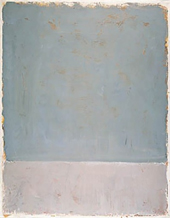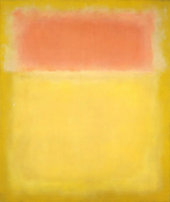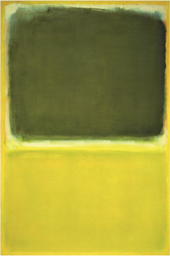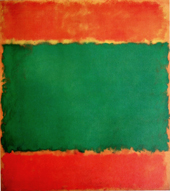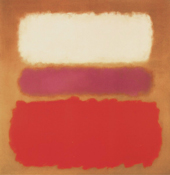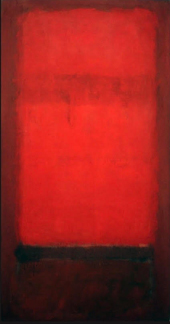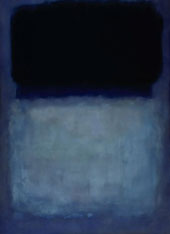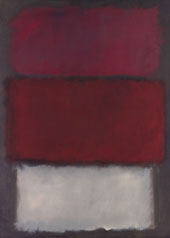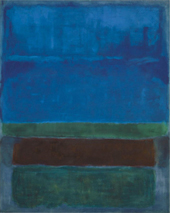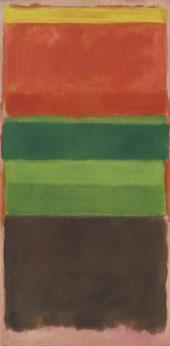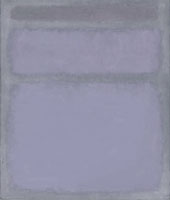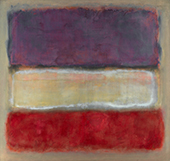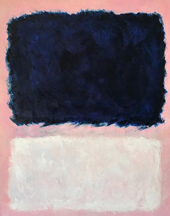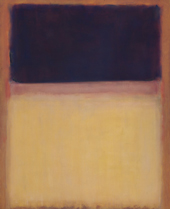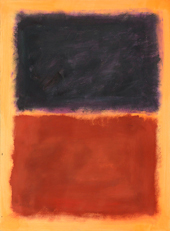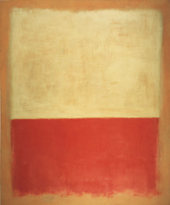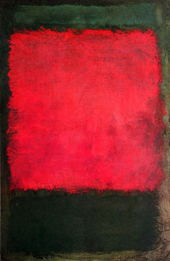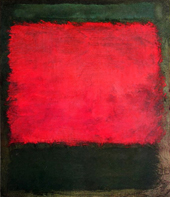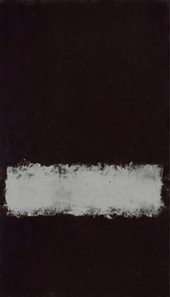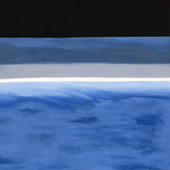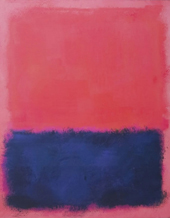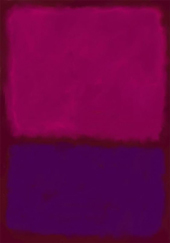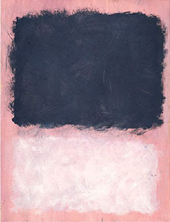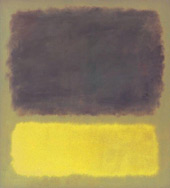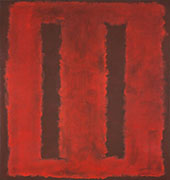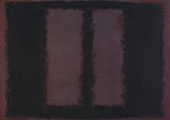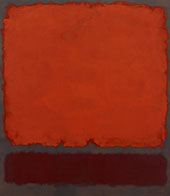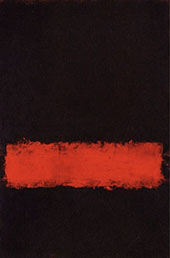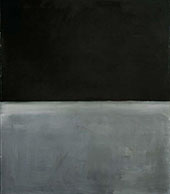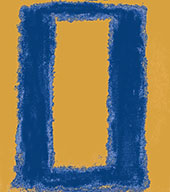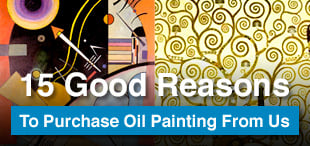Color Field Painting Oil Painting Reproductions
Find Color Field Painting Replicas by Color Field artists
Color Field Painting: A Brief Introduction
Color field painting refers to the art of pioneering abstract painters working in the 1950s and the 1960s. Characterized by “fields” of flat colors, it transformed how people thought about American art and creativity. This brief introduction introduces some of the most famous color field artists, their inspirations, and leading color field paintings.
Why is it called the Color Field painting?
Color Field paintings refer to artworks primarily using large areas or fields of color.
Irving Sandler identified three American Expressionist painters, Barnett Newman, Clyfford Still, and Mark Rothko, as "color field painters." The name derives from a book written by Sandler in his influential publication Abstract Expressionism\; Sandler titled one chapter “The Color Field Painters” and included the work of Rothko, Still, and Newman.
Clement Greenberg, an influential art critic of the time, also uses the term. Describing a new tendency amongst Abstract Expressionists for “all over color or color field,” the name stuck. Greenberg specifically used Mark Rothko’s painting Magenta, Black, and Green on Orange to illustrate this new approach.
Rothko claimed color was merely an instrument for his art, refusing to accept the terminology. Instead, he focused on intense emotions and religious experiences, saying that the color relationships in his oil paintings only moved people. Then he had missed his purpose.
What is Color Field Painting?
Originating in New York City, USA, in the late 1940s, color field artists took inspiration from both American Abstract Expressionism and European Modernism.
In terms of style, the critical characteristic of Color Field painting was large fields of solid, flat tones. In addition, color field artists often spread color thinly across an unprimed canvas. Sometimes they merely stained the surface of the canvas to create areas of unbroken pure color with limited thick impasto techniques.
Indeed, Color Field art placed less emphasis on brushstrokes and painterly effects. The technique opposes the dynamism of the Action Paintings of Jackson Pollock and Willem de Kooning. Instead, form, composition, and process were vital. The color was now free from objective and naturalistic concerns. Instead of a tool to depict people and forms, color became the primary subject.
Mark Rothko Colorfield Paintings
If there’s a single famous Color Field artist, it must be Mark Rothko. While he always avoided the Color Field label, his paintings are iconic examples of the genre.
Amongst Mark Rothko’s art, his best-known works are the Multiform paintings. These include works such as Number 8 Multiform 1949. Rothko communicated “basic human emotions” in their purest forms with these paintings. He focused on primary and extreme emotions: tragedy, ecstasy, fear, and doom.
Rothko’s paintings grew gradually darker from 1958 onwards. Indeed, in the early 1950s, bright yellows, oranges, and reds dominated. However, later in the decade and into the 1960s, this transformed into darker blues, grays, greens, and even blacks, as seen in Black and Maroon.
By the mid-1960s, Rothko’s paintings like Untitled Black and Gray were almost entirely composed of gray and black forms. These abstract creations increasingly took viewers into a dark, unknown world.
What is an example of Color Field Painting?
Rothko is the most famous Color Field artist today, taking deep inspiration from another artist, Clyfford Still. Paintings by Clyfford Still are some of the finest Color Field paintings representing the movement in its earliest and purest form. The expansive native landscapes of North Dakota inspired Clyfford Still to create his flat, minimalist compositions. PH-623 Prairie Winter and the enigmatic PH-113 are two such examples.
Still and Rothko met in the mid-1940s. They both taught at the California School of Fine Art in the late 1940s, now known as the San Francisco Art Institute. Unlike Rothko’s smoother, calmer compositions, Still's paintings often used quick flashes of contrasting colors. PH-1184 Is an example that his paintings give the impression that parts of the canvas rip and tear apart, revealing a hidden world. His creations are irregular and angular, using heavy surface texture and expression.
Intriguingly, however, the roots of the Color Field painting could run deeper. A later Color Field artist, Robert Motherwell, found paintings by Henri Matisse inspirational. If one considers French Window at Collioure by Henri Matisse, many critical characteristics of Color Field art appear. This oil painting has contrasting vertical bands of gray, black, and green, with thinly drawn paint over the surface of the canvas. It is a highly suggestive and intriguing oil painting on canvas.
What is the emphasis of Color Field paintings?
While Color Field art primarily refers to paintings of the 1950s and 60s, the style took a new direction from the mid-1960s onwards. A new generation of Color Field painters, including Helen Frankenthaler, Kenneth Noland, Jules Olitski, Morris Louis, and Sam Gilliam, used an even more abstract approach. Their paintings differ from the earlier works of Mark Rothko, Barnett Newman, and Clyfford Still, as emotional, mythical, and religious associations have disappeared.
Reflecting this shift, a Post-Painterly Abstraction exhibition was launched at the Los Angeles County Museum of Art in 1964. Organized by Clement Greenberg, it cemented the importance of the new 1960s generation of Abstract Color Field artists.
Color field painters were inspired, and the movement quickly spread to Great Britain, Australia, and Canada.
How do you create a Color Field Painting?
The creation of Color Field art required a key focus on color. Famous genre artists usually favored clean lines and gestalt principles. As a German word, this refers to geometric and graphic shapes. It is about freeing art from “unnecessary” components such as specific settings, objects, and poses. Instead, painting becomes controlled, calm, and regulated, with color used abstractly and psychologically.
To create a Color Field painting, please focus on the emotions you want to express and the color palette required. Furthermore, experiment with the more painterly effects of Barnett Newman and Clyfford Still. Review Barnett Newman’s paintings Achilles or Euclidian Abyss, or consider Mark Rothko’s stricter abstraction. Indeed, Newman later moved towards purer abstraction with humorously named artworks such as Who's Afraid of Red, Yellow, and Blue in 1967.
Oil painting on canvas produces the most stunning results, and leading Color Field artists often use create oversized wall art. Our resident professional artists create fine art reproductions by using British and Winsor Oil paints to create art reproductions.
Color Field Artworks - Replica Paintings for Sale
Discover the simplicity and abstract beauty of color field wall art and explore our extensive collection of famous oil paintings.
Modern art oil painting reproductions are for sale in every color palette.
Cannot Find What You Are Looking For?
Reproduction Gallery Information
Customer Service
(Send Us A Message)
Tel: (503) 937 2010
Fax: (503) 937 2011

